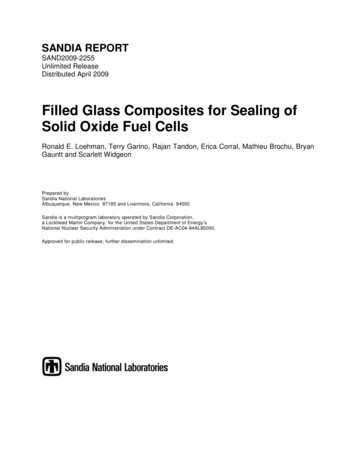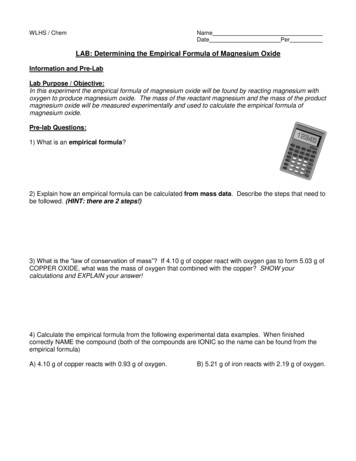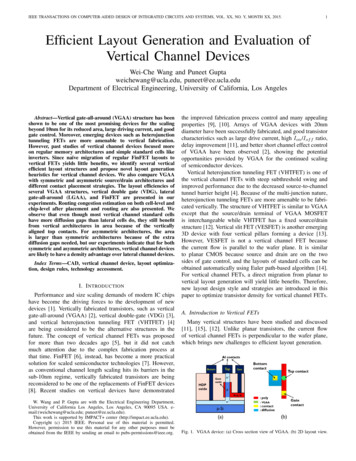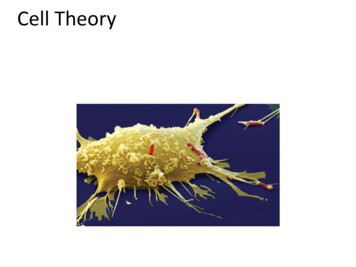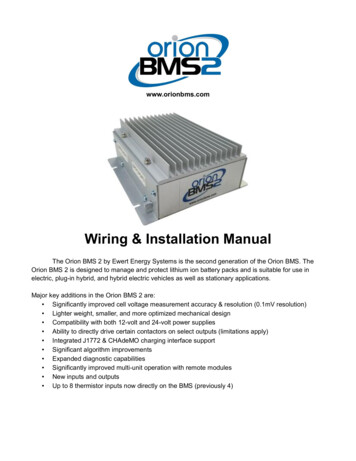
Transcription
Solid Oxide Electrolysis Cells (SOEC) integrated with DirectReduced Iron (DRI) plants for producing green steelJack Brouwer & Luca MastropasquaUniversity of California, IrvineDOE project award #DE-EE0009249August 31st, 2021
Project GoalsAdvance, demonstrate and optimize a thermally and chemically integrated Solid Oxide Electrolysis Cell(SOEC) system, as co-producer of H2 and O2, with a Direct Reduction Iron (DRI) plant at 1 ton/week ofproduct scale.Specific primaryenergyconsumption 8 GJ/tDRIElectric-tohydrogenefficiency for anSOEC stack of 35 kWh/kg ofH2 producedSpecific CO2emissions rate 90 kg CO2/tonDRI product w/ooxyfuelPilot system atproductioncapacity of 1ton/week andTRL 4Scale-up designfor a2 Mton/year DRIproduct capacityTotal capitalspecific cost 200/tonequivalent pigiron per yearTotal Project Budget: 5,664,862.00 – Total DOE Share: 4,043,993.00 – Total Cost Share: 1,620,869.00
Relevance/Potential ImpactSteel industry:World total 1869 Mtonsteel6-6.5% of total anthropogenicCO2 emissionsDirect Industrial CO2 emissionsChemicals andPetrochemicals13%Pulp and Paper3%Aluminium3%UnitsOther Industry26%Iron and Steel28%Cement27%Iron and SteelAluminiumChemicals and PetrochemicalsBlast Furnace Basic Oxygen Furnace (BF BOF)Hydrogen Direct Reduction (HDR)Hybrid Hydrogen Direct Reduction (Hybrid HDR)BF BOFHDRHybrid HDREnergy intensityGJ/toncrude steel19-20 8 9Specific emissionstonCO2/toncrude steel1.8-1.9 0.09 0.09Specific cost /toneq pig-iron yr210200*200*Electric loadGJel/toncrude steel- 7 7Ref SOECHDRHybrid HDR*At 2 Mton/yr scaleCementPulp and PaperOther IndustryWorldSteel association – World steel in figures 2020International Energy Agency (IEA)UnitsHydrogen Eff.kWh/kg4035-Syngas Eff.kWh/kg45-40Oxygen Eff.kWh/kg6.5 5 5
Project Work Packages
Hydrogen Direct Reduction (HDR) conceptVoltage 1.206 VElectrolysis sectionEfficiency 95%Hydrogen eat recovery& condenser191PurgeCO 2Storage/use24Burner(O2/NG)121813O2Fuel22Fe2O3 ( FeO Gangue)FilterSOECAnodeOperating Power 495 MWPressure 7 barReducing sectiondustCurrent Density 829 A/m2Steam Utilization 0.8936Preheating euseSteelSteam and co-electrolysisAirCooling& Fe3C24O2SOEC DRI layoutSteam map23(sol)6(gas)
Carbon Free Hydrogen from Nuclear Power9/2/2021 2021 Xcel Energy
Leading the Clean Energy TransitionA bold vision for a carbon-free future38%Reduction80%Reduction100%Carbon Free
NUCLEAR CONSORTIUM:WORKING FOR THE FUTURE OF NUCLEARPhased Approach - DOE Funded ScopePhase 1Install Low Temperature Electrolysis (LTE) Skid [Energy Harbor]Technical and Economic Assessments (due mid-2021) [Xcel Energy & APS]Phase 2Installation of High Temperature Steam Electrolysis (HTSE) Skid [Xcel Energy]Complete design work for Reversible HTSE skid [APS]Phase 3 – FutureExpansions on Phase 2 work, hydrogen storage, use demonstration, other. [TBD] 2021 Xcel Energy3
Producing Hydrogen From Carbon-free Nuclear Energy 2021 Xcel Energy4
Pilot Project Schedule Project must be completed within 2 years of funding receipt All dates pending receipt of fundingFunding available to start project1st Quarter 2022 2021 Xcel EnergyAll installation andtesting complete1st Quarter 2024Engineering complete4th Quarter 2022Notification of award10/8/2020Ship to PI forinstall3rd Quarter 2023
6
Hydrogen & IntegratedElectrolyzer Systems PanelNoah D. Meeks, Ph.D., P.E.R&DFor: Hydrogen Shot SummitSeptember 1, 2021Research & Development
Roadmap for Emerging Hydrogen ApplicationsIncrease utilization of existing infrastructure “Indirect Electrification” and value stacking Hydrogen competes against petrolScale decarbonized energy for transportationand industrial sectors Expand to chemical and thermal potentialDeep decarbonization of electricity operationsand delivered gas Bulk energy storage Central station H2-based power2
Transportation and resilient / peak shaving power are early mover marketsPowerElectrolysisHydrogenFuel CellsResilient andHigh-valuePowerTransportation: logistics, employees, customers, off-road Future: shipping, aviationPowerSecure Demo Demonstrate equipment performance Understand storage and scaling Develop strategic partnership with Plug PowerOPCO Distribution Center Integrate vehicle energy loads Develop strategic partnership with auto OEM Showcase customer opportunity for OPCOCustomer Sites Demonstrate value for customer Provide win-win-win-win for customer,Company, partners, and environment3
Hydrogen Production - Electrolysis Hydrogen production via electrolysis iscurrently 5% current US hydrogen market(not using clean electricity)Non-technology issues: Overall cost of hydrogen primarilya function of power price &capacity factor “Indirect electrification”viewed as competing with“electrification” efforts Technological cost drivers are efficiency,capital cost, and lifetime Geographic deploymentof fuel cell electric vehiclesuncertain Regulatory treatmentof electrolysis uncertainTarget H2 Cost( /kg)Target SystemCapex ( /kW)Target SystemEfficiency(kWh/kg)Average PowerPrice ( /kWh)Capacity FactorLifetime 0.320Note: 1/kg is target for power generation The capacity factor looks like energy storage.4
Hydrogen-based power generation is likely part of energy storage.Pre-combustion carbon captureNG may be blendedNatural GasReforming UnitHydrogen Pipeline /StorageCO2 (CCS)Fuel Cell or GasTurbinePowerH2 MarketsEnergy StorageElectrolysisWaterPowerHydrogen Pipeline /StorageFuel Cell or GasTurbineH2 MarketsPower
Cost reductions in energy storage are possible with technology.Hydrogen StorageEElectrolysisstacksFuel cellstacks(or H2GT)Conventional concept withseparate electrolysis andfuel cell systems Degrees of freedom aroundmultiple units Higher CAPEX More flexibilityHydrogen StorageESOFC/ECstacksLiquid chemicalhydride or metalhydrideEUnitized FC/EC Concept Lower CAPEX Simplified operation Less flexibilityEElectrolysisstacksFuel cellstacks(or H2GT)Integrated storage Concept Lower CAPEX Improved efficiency withheat integrationE
Hydrogen Shot SummitHybrid and Integrated Electrolyzer Systems PanelMichael G. GreenSeptember 1, 2021
Our Clean Energy Pathway2
Consortium: The Future of NuclearPhased Approach - DOE Funded ScopePhase 1Install Low Temperature Electrolysis (LTE) Skid [Energy Harbor]Technical and Economic Assessments (due mid-2021) [Xcel Energy & APS]Phase 2Installation of High Temperature Steam Electrolysis (HTSE) Skid [Xcel Energy]Complete design work for Reversible HTSE [APS]Phase 3 – FutureScale up LTE demonstration for hydrogen/natural gas co-firing and synthetic hydrocarbonproduction. [APS] 2021 Xcel Energy3
Project Summary and Status 20 MW low temperature electrolysiswith on-site compression and storage Objectives– Co-fire up to 30% hydrogen / 70% natural gasblend in natural gas fired power plant– Synthetic hydrocarbon production Status– Submitted funding application in April 2021– Anticipate work to begin first quarter 20224
Electrolysis – How does itplug in on the grid?Brittany Westlake, Ph.D.Sr. Technical Leader, Low-Carbon Resources InitiativeEPRIbwestlake@epri.comHydrogen Shot SummitSeptember 1, 2021www.lowcarbonLCRI.comwww.epri.com 2021 Electric Power Research Institute, Inc. All rights reserved.
Decarbonization Pathways Enabled by Innovation 15-30 years 10-15 yearsDecarbonizationDecarbonization2Accelerate economy-wide, low-carbonsolutions Electric sector decarbonization Transmission and grid flexibility:storage, demand, EVs Efficient electrificationAchieve a net-zero clean energy system Ubiquitous clean electricity:renewables, advanced nuclear,CCUS Negative-emission technologies Low-carbon resources: hydrogenand related, low-carbon fuels,biofuels, and biogaswww.epri.com 2021 Electric Power Research Institute, Inc. All rights reserved.
The Low-Carbon Resources Initiative (LCRI) is a five-year R&D commitment focused on theadvancement of low-carbon technologies for large-scale deployment across the energy economy.This initiative is jointly led by EPRI and GTI.FOCUSMultiple options andsolutions to establish viablelow-carbon pathwaysRESEARCH rivative FuelsIntegratedEnergy SystemsNH3SynStorage &Deliverywww.lowcarbonLCRI.comIndependent, objectiveresearch leveraged by globalengagement andcollaborationComprehensive value chainapproach across adjacentsectorsEnd hnologies for hard-todecarbonize areas of theenergy economyAffordable, reliable, andresilient integrated energysystems for the futureVALUE 2021 Electric Power Research Institute, Inc. All rights reserved.High-impact resultsthat accelerate technologytime to market
Economy-Wide Low-Carbon Energy PathwaysPrimary EnergyConversionStorage and DeliveryEnergy End-UseDistributed CHPAmmoniaHydrogenProductionNatural GasAmmonia SynthesisElectricity InputsPetroleum elingInfrastructureCaptured CO2On-RoadBioenergy &WasteCaptureFuelSynthesisBio-RefiningDirect Air Capture4Transportationwww.lowcarbonLCRI.com 2021 Electric Power Research Institute, Inc. All rights reserved.ConventionalSyntheticBiofuelNatural ClimateSolutionsLiquid Fuels
Integration of Alternative Energy CarriersH2 DeliveryH2 ProductionH2 End-UseNuclearBoilerHeavy DutyTransportationElectric GenerationAdvancedFuel CellLarge IndustryChemical ProcessElectrolysisUtilize Existing or Develop New PipelinesCleanGenerationNaturalGas CCS5H2 Storage and Transportwww.lowcarbonLCRI.com 2021 Electric Power Research Institute, Inc. All rights reserved.
Relevance/Potential Impact Iron and Steel 28% Cement Aluminium 27%. 3%. Pulp and Paper 3%. Chemicals and Petrochemicals 13%. Other Industry 26%. Direct Industrial CO2 emissions


